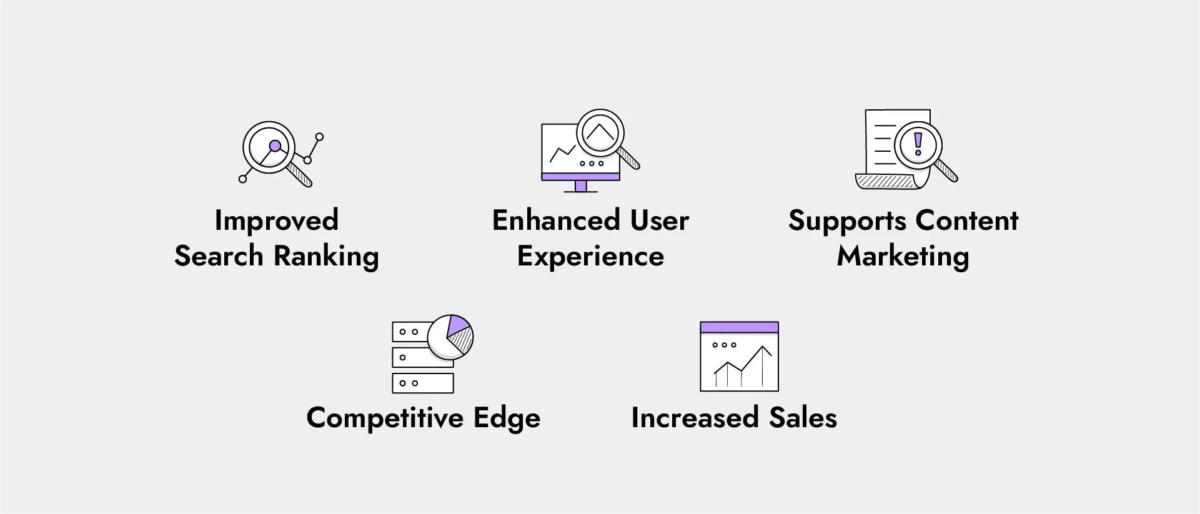If you want to succeed in the enormous e-commerce world and sell your products, you need to have your product pages in perfect shape. To achieve this, you need to follow the latest SEO trends for page optimization and site structure and implement useful ones on your Shopify website. Even though, page optimization includes many factors besides the product descriptions, still those have a huge influence on ranking.
Getting the proper people to notice your store is essential and Shopify SEO can help with that. It takes more than just writing attractive product descriptions to increase sales. Well-written descriptions can persuade a visitor to make a purchase, but your efforts will be useless if those descriptions aren’t seen in search results. You can uncover the full potential of your product pages and turn them into revenue-generating engines for your Shopify store by adhering to the best practices.
With a specific focus on Shopify SEO, we’ll guide you through strategies to enhance your store’s visibility, improve user experience, and ultimately increase sales.
Understanding Shopify SEO
Product pages are are the most important things when it comes to managing a profitable Shopify store. They serve as your battlefield for converting infrequent visitors into devoted patrons. However, how can you ensure that your product pages are prepared to prevail in this conflict? Product page optimization is the solution.
To transform your product pages into conversion engines and improve your Shopify SEO, you must carefully review and update their functionality, design, and content.
Here’s how product page optimization works its magic!
High-quality Content is Crucial
It all starts with the words you use to describe your products. Craft compelling product descriptions that are informative, engaging, and packed with relevant keywords. Search engines love informative content, and it helps potential customers understand exactly what you’re selling.
A Picture is Worth a Thousand Sales
High-quality visuals are crucial for product pages. Show off your products from every angle with clear images. Consider including lifestyle photos to showcase your products in action and spark customer imagination. Conversion rate can be impacted by photos, as 85% of consumers believe that product details and photos play a significant role in their decision to choose one brand over another.
Price it Right, Sell it Fast
Competitive pricing is essential, but don’t forget about strategic presentation. Experiment with different pricing formats and display options to find what resonates most with your target audience.
The Power of Persuasion
Customer reviews are like social proof – they build trust and convince potential customers to take the plunge. Actively encourage customers to leave reviews and strategically showcase positive testimonials on your product pages.
The Call to Action
Don’t leave customers guessing what to do next if Shopify SEO is important to you. Include clear and compelling calls to action (CTAs), like “Add to Cart” or “Buy Now” buttons. Make sure your CTAs stand out visually and guide customers effortlessly towards the purchase. Test your product pages on various browsers and mobile devices to make sure your call to action is prominently displayed regardless of how your customers are shopping online, as over 60% of e-commerce purchases in the United States are made on smartphones. Mobile optimization is crucial, especially for displaying the CTA properly.
URL Structure
Customizing your Shopify store’s URL structure for optimal SEO performance involves two critical steps. Firstly, ensure your URLs are user-friendly and descriptive, such as “site.com/category/product-name” instead of relying on parameterized URLs like “site.com/shop?id=123”. While URL parameters are useful for tracking, they should not dominate your URL structure as they can hinder search engine visibility. When adjusting your URL format, it’s essential to review and update internal links and plan redirects for any external backlinks to maintain SEO integrity.
Secondly, simplify your URL hierarchy by avoiding overly complex structures. Rather than deep nesting like “site.com/shop/category/subcategory/product”, aim for a streamlined approach that balances clarity and relevance. This approach helps both users and search engines navigate your site more effectively, improving overall user experience and SEO rankings. By optimizing your Shopify store’s URL structure in these ways, you can enhance visibility, attract more organic traffic, and ensure a smoother navigation experience for your customers.
What are SEO Product Descriptions?
Shopify SEO product descriptions are like neon signals blazing in the digital darkness of the e-commerce industry. They draw in potential clients who are looking for particular products, just like magnets do.
These descriptions are filled with well-chosen words and phrases that reflect customers’ precise terms while searching for things online. They are written for e-commerce sites such as toy and apparel boutiques. E-commerce websites that use these components and follow SEO trends improve their search engine ranking and reach a larger audience by increasing the visibility of their items.
Benefits of SEO-friendly Product Descriptions

- Improved Search Ranking: Keywords help search engines like Google determine the subject matter of your product pages. Your chances of ranking better in search results for such topics rise when you organically include relevant keywords in your descriptions. Include relevant buzzwords like “leak-proof,” “insulated,” “coffee mug,” or “travel tumbler” in your description if, for instance, you’re offering a “stainless steel travel mug.”
- Enhanced User Experience: Not all descriptions optimized by search engines are merely keyword stuffing. They provide your consumers with useful information. Consider yourself a salesperson for a “wireless noise-cancelling headphone.” Its salient characteristics (battery life, Bluetooth connectivity), advantages (better sound quality, clear conversations), and target market (regular travellers, audiophiles) should all be highlighted in your description. Customers are empowered to feel secure in their purchases and make well-informed decisions as a result.
- Increased Sales: Sales may be greatly increased by providing concise, helpful explanations that target consumer trouble areas. Assume you are a vendor of “organic cotton t-shirts”. Mention the fabric’s breathability, the environmentally responsible components, and the snug fit. You increase the likelihood of converting interested shoppers into purchases by emphasizing the value offer.
- Competitive Edge: In a highly competitive market, having unique and compelling product descriptions that are also SEO-optimized can set your products apart from others. This distinctiveness can be a deciding factor for customers when choosing between similar products on different sites.
- Supports Content Marketing: SEO-friendly product descriptions can be repurposed as high-quality content for marketing campaigns, such as in newsletters, social media posts, and promotional materials. This consistency in SEO efforts across all platforms reinforces your brand’s message and improves overall marketing effectiveness.
How to Craft Proper SEO-Optimized Descriptions for Your Shopify?
- Keywords
- Target Relevant Keywords: To better your Shopify SEO do some keyword research and include important ones in all of your product descriptions. These keywords need to be representative of potential searches made by your clients for related goods and will increase your organic traffic.
- Natural Integration: After you’re done with the keyword research and pick the significant and potential target keywords, avoid overusing those in your content and stick to the latest SEO trends. Include them in the description without any trouble at all to make sure the writing flows well and offers insightful information.
- Content
- Clear and Concise: Compose precise, succinct descriptions of the product that are easy to read. Pay attention to the salient characteristics and advantages that will entice your intended audience.
- Highlight Value Proposition: Explain how the product solves a problem or improves the customer’s life.
- Target Audience: Use language and tone that resonate with your target audience.
- Unique Descriptions: Steer clear of general descriptions. Make distinctive and captivating high-quality content to differentiate yourself from your competitors. Each product description has to be maximally unique and not similar to the descriptions of your other products. Some information will indeed be repeated from other product listings. It’s impossible to add your personal touch to a product’s measurements or serial number. But you can guarantee that everything else is distinct.
Copying product descriptions verbatim from manufacturer websites is one of the simplest mistakes that many owners of Shopify stores make and reduces their organic traffic. This results in duplicate material with the producer as well as with other retailers that also offer the goods and have duplicated the description.
- Technical Aspects
- Optimal Length: While there’s no one-size-fits-all answer, aim for informative descriptions without being overwhelming. Generally, 200-500 words are a good starting point for Shopify SEO but should bet adjusted based on product complexity. Make sure to use your keyword research data.
- Bullet Points and Lists: Break up text with bullet points and lists for improved readability and easier scanning.
- Mobile-Friendly Formatting: Ensure your descriptions are formatted for mobile devices, as many customers browse and shop on their phones.
- Image Texts: The two primary functions of alt text on Shopify product photos are SEO and accessibility. Alt text offers essential picture explanations for screen reader users who are visually challenged, making sure that everyone can explore your business.
Furthermore, by using relevant keywords in your alt text descriptions, you may raise your image search score and draw in potential buyers who first browse products through images. Remember that alt text should be concise, clear, and concentrated on the features of the product rather than on sales.
To thrive in the competitive e-commerce landscape and drive sales through your Shopify store, optimizing your product pages is essential. Beyond crafting compelling product descriptions, which play a pivotal role in influencing purchasing decisions, leveraging effective SEO strategies is paramount. Link building enhances your site’s authority, while on-page SEO ensures your content is relevant and well-structured for search engines. Implementing structured data enhances visibility in search results, and focusing on technical SEO and site speed optimizes the user experience.
By integrating these practices into your Shopify SEO strategy, you can improve visibility, attract more qualified traffic, and ultimately increase conversions. Stay updated with SEO trends and continuously refine your approach to maintain a competitive edge.




